The Wait
To be a dog is to learn to wait. Waiting dogs are ends in themselves — they
must wait, or we have failed in their training. We teach our dogs to wait
and then we exploit this, pushing waiting to its limits. Wait and sit until
told to come.
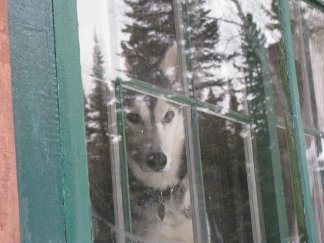 Wait with a marshmallow balanced on your snout until told to
snap it out of the air. Wait with your bladder achingly full while the
others sleep languorously through the mounting morning hours. Wait by the
sliding door for an entire day shift, listening first for the familiar
muffled engine, then for the familiar wheels on gravel, and finally the
flickering shadows in the slats between the fence boards, your signal to
finally celebrate that you have not been abandoned, after all. All this
waiting is in service to us. Dogs are our companions in waiting, becoming
our pals at our pleasure.
Wait with a marshmallow balanced on your snout until told to
snap it out of the air. Wait with your bladder achingly full while the
others sleep languorously through the mounting morning hours. Wait by the
sliding door for an entire day shift, listening first for the familiar
muffled engine, then for the familiar wheels on gravel, and finally the
flickering shadows in the slats between the fence boards, your signal to
finally celebrate that you have not been abandoned, after all. All this
waiting is in service to us. Dogs are our companions in waiting, becoming
our pals at our pleasure.
Daisy, my husky pal, waited long days in the woods while I built structures,
chainsawed, and hauled brush. She waited for the exhilarating moment when
she’d be released from the tether for the short walk back to the cabin where
she would wait, for something, again.
 Sometimes the reward for a wait would
be the Holy Grail: in the early years a long road run; lately a long hike
through the ubiquitous woods where we live, along exposed ridges surveying
our greatest of lakes, or picking and poking our way along the endlessly
fascinating shorescapes.
Sometimes the reward for a wait would
be the Holy Grail: in the early years a long road run; lately a long hike
through the ubiquitous woods where we live, along exposed ridges surveying
our greatest of lakes, or picking and poking our way along the endlessly
fascinating shorescapes.
When Daisy was between puppyhood and full-grown, I was 51. I was still
running long races and took her for her first long training run. When we
returned to the back yard gate, I was physically spent but she yearned to
dash into the yard and scatter the birds and squirrels she knew would be
flocking the seed-covered ground beneath the feeder. But I made her wait as
I bent down, unsnapped her leash, and hugged her, whispering, “Thank you,
Daisy, thank you. Let’s make a deal and vow to be doing this when I am 65
and you are 15.” Then I let her go to witness the first display of what
would become the iconic Daisy maneuver: a powerful dash across the yard
courtesy of her husky side, and the graceful leap across the sidewalk from
the greyhound in her.
Eventually these elemental acts evolved into “Get The Girl,” a frenetic
combination of power and dance, with tufts of sod and dirt clawed into the
air on mad traverses along the big yard’s perimeter, hairpin turns around
trees at full speed, then, finally, a launch from the deck into a sailing
leap over the 5-step staircase, continuing over the stone patio onto the
grass a full 12 feet from her take-off.
 It was a celebration of everything
it was to be young, vital, and Daisy. Like all things in the blush of new
growth, she seemed indestructible.
It was a celebration of everything
it was to be young, vital, and Daisy. Like all things in the blush of new
growth, she seemed indestructible.
Now I am 61 and ten years have passed. The last deck-launch was two years
ago. The last “Get The Girl” was three months ago, when she yelped in pain
during a hairpin turn in the yard, her last. She was 10. I thought she
pulled a muscle and chalked it up to her first indignity of age, a factor
that has come to dominate my life as well.
* * * * * * *
While Daisy was a beautiful specimen (I wish I had a dollar for every
compliment she received on walks) and while she acted in dog-like ways, from
those yard dashes, to barking loudly at house callers, she did not excel at
being a dog. She had higher aspirations.
Daisy was rescued from a December litter born in a barn by crawling up my
wife’s leg while her litter mates balled together on the dirt by a frozen
water dish.
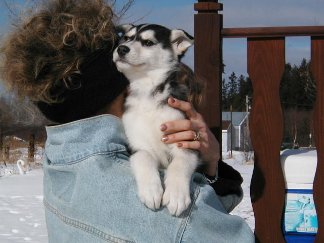 She failed puppy and dog training, miserably, while the
instructor noted, “This dog is very smart — she is aware of everything
happening around her.” Too smart to be bothered to learn to sit while
bombarded by input from the sounds, smells, and sights of the training arena,
all of which were far too fascinating to sit calmly and wait for the inane
command to “come”. Too fascinating and, it would turn out, too fearful to
simply ignore in the service of being a dog for some human’s sense of species
control.
She failed puppy and dog training, miserably, while the
instructor noted, “This dog is very smart — she is aware of everything
happening around her.” Too smart to be bothered to learn to sit while
bombarded by input from the sounds, smells, and sights of the training arena,
all of which were far too fascinating to sit calmly and wait for the inane
command to “come”. Too fascinating and, it would turn out, too fearful to
simply ignore in the service of being a dog for some human’s sense of species
control.
The first time a chickadee scolded her, Daisy slunk away from the bird feeder
in fear. Wheelbarrows, rakes, and shovels, when moved, sent her hiding
behind the woodpile, and of course I learned early on never to start the lawn
mower while she was in the yard. When a bag of groceries appeared suddenly
by the back door, she gave it wide berth. Scrunch up an empty potato chip
bag to toss, and the sound would send her on her way from the scary kitchen
to the safe living room, her unfinished meal left behind. Foreign objects,
foreign sounds, even foreign smells scared her — one calm and dark evening
her fear sent her to the third floor, the reason cloaked in mystery until we
discovered a bear and her cubs making their way across the porch.
While she gave bears the respect they are due, she took on the smaller
mammals with panache and dispatched many a chipmunk, squirrel, vole, and
bunny. And like many dogs, she had her initiation into the Cult Of Skunk,
taking a direct hit in the face. As awful as that was for her, it had the
effect of bonding her and me, as she trusted and depended on me to hose her
and work the detergent and bleach into her fur, avoiding her eyes as they
pleaded with me to make her feel better. It was one of many experiences that
bonded us, and in time she did indeed learn to come any time I called, not
because it was a command that had to be followed, but because she wanted to.
Daisy was a creature in a dog’s body who wanted to turn up the speed on
Darwin’s clock and evolve, right now, into something else. My wife is
convinced that for a time Daisy had her eyes on the prize of being the alpha
female in our pack, and for several years early on there ensued a battle
between the two of them until they sorted it out. Still, even years later
when my wife and I hugged, Daisy would grow jealous and try to break it up,
or at least be involved in the hugging herself.
 She contradicted the adage
never to engage dogs in staredowns on pain of driving them crazy, as gazing
into Daisy’s eyes at close range, forehead to forehead, was like staring into
a mirror at eyes that refuse to lose their grip. A true empath, she sensed
your pain, sorrow, and joy, and made them her own.
She contradicted the adage
never to engage dogs in staredowns on pain of driving them crazy, as gazing
into Daisy’s eyes at close range, forehead to forehead, was like staring into
a mirror at eyes that refuse to lose their grip. A true empath, she sensed
your pain, sorrow, and joy, and made them her own.
She wanted desperately to talk to us. Not bark, or howl, but talk. She
couldn’t form the words of course, but her discourse was full of question
marks, blurtings of pent-up frustration, joyful songs of recognition and
reunion, and, increasingly as she matured, mutterings that demanded to take
their place amid the ambient chatter of our household. A family friend
finally decoded many of these mutterings as “Why, why, why, …?” and as her
later years unfolded it made perfect sense.
Daisy was the only dog I ever knew who absolutely hated to travel. The cruel
irony, of course, was that she loved the cabin and its environs — the shore,
the trails, the beach house, the studio (although she assiduously avoided
wood floors, because they scared her). The 2½ hour drive became an endurance
test of panting and shaking as every road bump and passing 18-wheeler set her
heart pounding. These stresses would take their toll, and combined with the
empathic curse of absorbing the anxieties and sorrows of those she loved,
Daisy developed colitis. While we initially attributed the debilitating
diarrhea to raccoon feces in the yard (despite her higher aspirations, Daisy
could not resist such morsels), we came to understand that the cause was
stress, and we adapted our lives to this new parameter. The management of
colitis would come to dominate Daisy’s life, and it had the welcome effect of
teaching us to mitigate the expression of our own pains and worries, for the
sake of her.
Daisy insinuated herself into our hearts like no being before or since. She
was the touchstone of all parts of the day, participating in the sights and
sounds of every scene from the narrative of our lives.
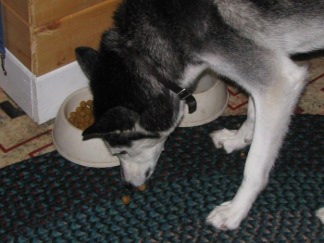 We preferred watching
Daisy eat to watching television, so fascinating and endearing were her
attempts to find the one piece of kibble that was superior to all the others.
She would with great purpose alternate between eating daintily and lapping
her water, like a gourmand accenting her entrée with sips of fine wine. She
loved roasted peanuts, but only if they were shelled. She would wait until
given one, then patiently remove the thin, papery membrane to get at the nut
meat inside, leaving little piles of saliva-soaked peanut skin on the floor
for me to pick up. Then she would stare, entranced, for long moments into
her water bowl as if to divine some important truth, or maybe just to
converse with the eyes staring back at her in the reflection.
We preferred watching
Daisy eat to watching television, so fascinating and endearing were her
attempts to find the one piece of kibble that was superior to all the others.
She would with great purpose alternate between eating daintily and lapping
her water, like a gourmand accenting her entrée with sips of fine wine. She
loved roasted peanuts, but only if they were shelled. She would wait until
given one, then patiently remove the thin, papery membrane to get at the nut
meat inside, leaving little piles of saliva-soaked peanut skin on the floor
for me to pick up. Then she would stare, entranced, for long moments into
her water bowl as if to divine some important truth, or maybe just to
converse with the eyes staring back at her in the reflection.
Nothing delighted us more when, upon settling in the living room of an
evening to share and discuss our day, Daisy would dash up to the third floor
to quickly return with her favorite toy to chew, beloved to her as the
glasses of wine were to us in the gathering of the pack. And she loved to
repair to the third floor when it was finally time to retire.
 She would
collect her toy, lead the trundling group up the flights of stairs, and
eagerly curl up on the afghan-draped bed. Whereupon we would find — buried
under the pillows and quilts — socks, gloves, washcloths, or cloth table
mats, the results of a ritual she developed to deal with the long waits of
the day and a full understanding of which we shall never have, though it
never ceased to amaze and delight us. I would then fall asleep with my hand
on her fur as she lay on the bed, her heart calm, her body strong, with the
promise of many more miles on the local trails to go after we sleep.
She would
collect her toy, lead the trundling group up the flights of stairs, and
eagerly curl up on the afghan-draped bed. Whereupon we would find — buried
under the pillows and quilts — socks, gloves, washcloths, or cloth table
mats, the results of a ritual she developed to deal with the long waits of
the day and a full understanding of which we shall never have, though it
never ceased to amaze and delight us. I would then fall asleep with my hand
on her fur as she lay on the bed, her heart calm, her body strong, with the
promise of many more miles on the local trails to go after we sleep.
* * * * * * *
It was like this, just like this, until just weeks ago. I was sure Daisy, 10
and vital, colitis and all, had at least a third of her life left and we had
at least five more years together. I counted on it, having over the course
of the two previous years lost my cat, my father, a dear friend, and my only
child to various conspiracies of fate. Instead, Daisy is gone, only my wife
and I are left standing, and what was left of the emotional scaffolding of
our lives has collapsed.
The speed and manner of Daisy’s passing changed the very fabric of who we
are. While she suffered with spinal cancer it was our turn to wait. Wait
for diagnoses, wait for results, and wait for signs that the end was near.
It is hard for me to not think of it as payback for the waiting we make dogs
do. If not payback, certainly an obligation. Once our perfunctory and angry
denial was over and we realized we were counting down weeks, if not days, to
the end, all anger, disbelief, and rationalization ceased, and every effort
went toward easing Daisy’s pain and reminding her of how much she was loved.
We no longer had a sense of our own time or schedule. We were on Daisy Time,
and we were in for an extreme exercise in empathy. But we had to jettison
our emotions. We could not cry or wail or weep in her presence. We could
not leave the room, or she would cry, not necessarily out of pain, but
because she wanted the pack together. She knew.
When she could no longer negotiate stairs, the three of us took up residence
on the first floor, on mattresses near the sliding deck door, where we all
would watch as the chipmunks and squirrels reclaimed the back yard and
flocking sparrows and chickadees grabbed seed and occasionally banged into
the window glass, all to the disinterest of Daisy, whose body was wasting
away seemingly by the hour and whose breathing became labored.
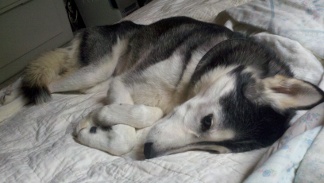 Because we wanted the end to come for Daisy at home, and because our vet
would accommodate this, we found ourselves waiting through an agonizing
weekend, a wait artificially imposed by the human calendar and for which I
feel human shame. But we will never forget her heroic effort on that Sunday,
her last afternoon, to struggle to her feet for a tottering shuffle to the
grass to relieve herself for the last time, an action that, thanks to
powerful medications, gave her a relatively peaceful night while we all slept
together on the floor, waiting for the morning and the arrival of the vet.
Then waiting for the sedative to take effect. Waiting for the syringe to
find a vein. Waiting for her breathing to stop. Waiting for the vet to
announce her heart had stopped. Waiting for her body to be carried to the
van. Then, finally, release.
Because we wanted the end to come for Daisy at home, and because our vet
would accommodate this, we found ourselves waiting through an agonizing
weekend, a wait artificially imposed by the human calendar and for which I
feel human shame. But we will never forget her heroic effort on that Sunday,
her last afternoon, to struggle to her feet for a tottering shuffle to the
grass to relieve herself for the last time, an action that, thanks to
powerful medications, gave her a relatively peaceful night while we all slept
together on the floor, waiting for the morning and the arrival of the vet.
Then waiting for the sedative to take effect. Waiting for the syringe to
find a vein. Waiting for her breathing to stop. Waiting for the vet to
announce her heart had stopped. Waiting for her body to be carried to the
van. Then, finally, release.
* * * * * * *
It is no profundity to claim that every experience shapes who we are, but
after living through Daisy’s decline and death, I will never be the same. I
have always known that the divine directive to hold dominion over the animals
is a fiction, but the relationship we have with them does carry with it a
divine burden. To be on death watch is one thing. But to actually make the
call is quite another.
Daisy taught me many things, including to no longer believe with swagger that
I still have a third of my life to live. When I am faced with my own
endgame, the memory of the grace with which Daisy handled hers will shame any
inclination I might have toward self-pity. I doubt that true happiness is
possible in modern life, but the discipline of Daisy Time taught me what it
means to live in the moment and find meaning there in a timeless, knife-edged
instant.
Thank you, Daisy, for your short and remarkable life. You have taught me
that love knows no species boundaries, and that unconditional love is
prepared to wait a lifetime.
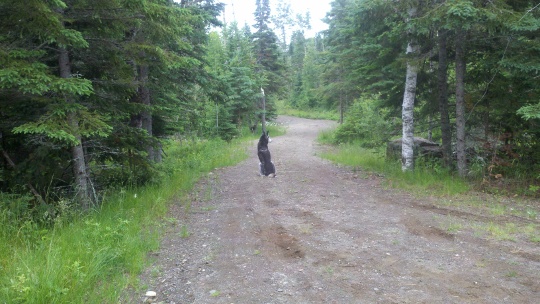
Tim Colburn
Duluth, MN
November 2013
 Wait with a marshmallow balanced on your snout until told to
snap it out of the air. Wait with your bladder achingly full while the
others sleep languorously through the mounting morning hours. Wait by the
sliding door for an entire day shift, listening first for the familiar
muffled engine, then for the familiar wheels on gravel, and finally the
flickering shadows in the slats between the fence boards, your signal to
finally celebrate that you have not been abandoned, after all. All this
waiting is in service to us. Dogs are our companions in waiting, becoming
our pals at our pleasure.
Wait with a marshmallow balanced on your snout until told to
snap it out of the air. Wait with your bladder achingly full while the
others sleep languorously through the mounting morning hours. Wait by the
sliding door for an entire day shift, listening first for the familiar
muffled engine, then for the familiar wheels on gravel, and finally the
flickering shadows in the slats between the fence boards, your signal to
finally celebrate that you have not been abandoned, after all. All this
waiting is in service to us. Dogs are our companions in waiting, becoming
our pals at our pleasure.
 Sometimes the reward for a wait would
be the Holy Grail: in the early years a long road run; lately a long hike
through the ubiquitous woods where we live, along exposed ridges surveying
our greatest of lakes, or picking and poking our way along the endlessly
fascinating shorescapes.
Sometimes the reward for a wait would
be the Holy Grail: in the early years a long road run; lately a long hike
through the ubiquitous woods where we live, along exposed ridges surveying
our greatest of lakes, or picking and poking our way along the endlessly
fascinating shorescapes.
 It was a celebration of everything
it was to be young, vital, and Daisy. Like all things in the blush of new
growth, she seemed indestructible.
It was a celebration of everything
it was to be young, vital, and Daisy. Like all things in the blush of new
growth, she seemed indestructible.
 She failed puppy and dog training, miserably, while the
instructor noted, “This dog is very smart — she is aware of everything
happening around her.” Too smart to be bothered to learn to sit while
bombarded by input from the sounds, smells, and sights of the training arena,
all of which were far too fascinating to sit calmly and wait for the inane
command to “come”. Too fascinating and, it would turn out, too fearful to
simply ignore in the service of being a dog for some human’s sense of species
control.
She failed puppy and dog training, miserably, while the
instructor noted, “This dog is very smart — she is aware of everything
happening around her.” Too smart to be bothered to learn to sit while
bombarded by input from the sounds, smells, and sights of the training arena,
all of which were far too fascinating to sit calmly and wait for the inane
command to “come”. Too fascinating and, it would turn out, too fearful to
simply ignore in the service of being a dog for some human’s sense of species
control.
 She contradicted the adage
never to engage dogs in staredowns on pain of driving them crazy, as gazing
into Daisy’s eyes at close range, forehead to forehead, was like staring into
a mirror at eyes that refuse to lose their grip. A true empath, she sensed
your pain, sorrow, and joy, and made them her own.
She contradicted the adage
never to engage dogs in staredowns on pain of driving them crazy, as gazing
into Daisy’s eyes at close range, forehead to forehead, was like staring into
a mirror at eyes that refuse to lose their grip. A true empath, she sensed
your pain, sorrow, and joy, and made them her own.
 We preferred watching
Daisy eat to watching television, so fascinating and endearing were her
attempts to find the one piece of kibble that was superior to all the others.
She would with great purpose alternate between eating daintily and lapping
her water, like a gourmand accenting her entrée with sips of fine wine. She
loved roasted peanuts, but only if they were shelled. She would wait until
given one, then patiently remove the thin, papery membrane to get at the nut
meat inside, leaving little piles of saliva-soaked peanut skin on the floor
for me to pick up. Then she would stare, entranced, for long moments into
her water bowl as if to divine some important truth, or maybe just to
converse with the eyes staring back at her in the reflection.
We preferred watching
Daisy eat to watching television, so fascinating and endearing were her
attempts to find the one piece of kibble that was superior to all the others.
She would with great purpose alternate between eating daintily and lapping
her water, like a gourmand accenting her entrée with sips of fine wine. She
loved roasted peanuts, but only if they were shelled. She would wait until
given one, then patiently remove the thin, papery membrane to get at the nut
meat inside, leaving little piles of saliva-soaked peanut skin on the floor
for me to pick up. Then she would stare, entranced, for long moments into
her water bowl as if to divine some important truth, or maybe just to
converse with the eyes staring back at her in the reflection.
 She would
collect her toy, lead the trundling group up the flights of stairs, and
eagerly curl up on the afghan-draped bed. Whereupon we would find — buried
under the pillows and quilts — socks, gloves, washcloths, or cloth table
mats, the results of a ritual she developed to deal with the long waits of
the day and a full understanding of which we shall never have, though it
never ceased to amaze and delight us. I would then fall asleep with my hand
on her fur as she lay on the bed, her heart calm, her body strong, with the
promise of many more miles on the local trails to go after we sleep.
She would
collect her toy, lead the trundling group up the flights of stairs, and
eagerly curl up on the afghan-draped bed. Whereupon we would find — buried
under the pillows and quilts — socks, gloves, washcloths, or cloth table
mats, the results of a ritual she developed to deal with the long waits of
the day and a full understanding of which we shall never have, though it
never ceased to amaze and delight us. I would then fall asleep with my hand
on her fur as she lay on the bed, her heart calm, her body strong, with the
promise of many more miles on the local trails to go after we sleep.
 Because we wanted the end to come for Daisy at home, and because our vet
would accommodate this, we found ourselves waiting through an agonizing
weekend, a wait artificially imposed by the human calendar and for which I
feel human shame. But we will never forget her heroic effort on that Sunday,
her last afternoon, to struggle to her feet for a tottering shuffle to the
grass to relieve herself for the last time, an action that, thanks to
powerful medications, gave her a relatively peaceful night while we all slept
together on the floor, waiting for the morning and the arrival of the vet.
Then waiting for the sedative to take effect. Waiting for the syringe to
find a vein. Waiting for her breathing to stop. Waiting for the vet to
announce her heart had stopped. Waiting for her body to be carried to the
van. Then, finally, release.
Because we wanted the end to come for Daisy at home, and because our vet
would accommodate this, we found ourselves waiting through an agonizing
weekend, a wait artificially imposed by the human calendar and for which I
feel human shame. But we will never forget her heroic effort on that Sunday,
her last afternoon, to struggle to her feet for a tottering shuffle to the
grass to relieve herself for the last time, an action that, thanks to
powerful medications, gave her a relatively peaceful night while we all slept
together on the floor, waiting for the morning and the arrival of the vet.
Then waiting for the sedative to take effect. Waiting for the syringe to
find a vein. Waiting for her breathing to stop. Waiting for the vet to
announce her heart had stopped. Waiting for her body to be carried to the
van. Then, finally, release.
